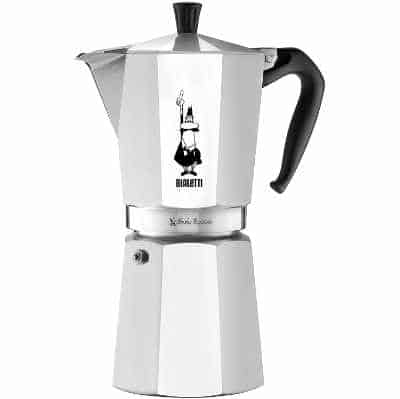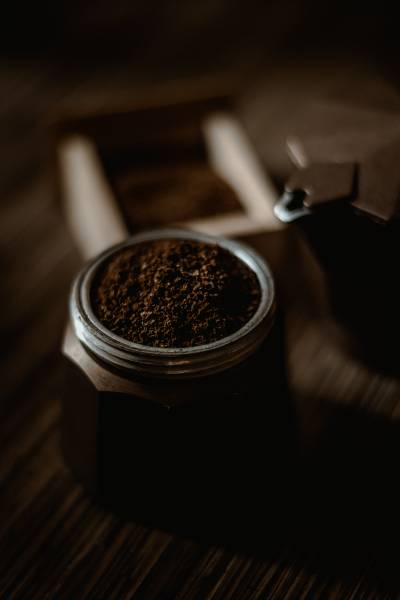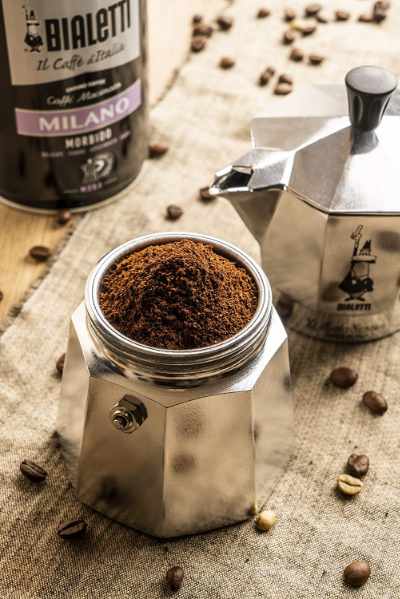The Bialetti Moka Express is iconic. It may appear kind of similar to a coffee percolator but this little device holds its own in the coffee-making world. It’s artistic in design and nostalgic for many of us who remember parents or grandparents brewing coffee in one of these.
This little metal device brews coffee using heat from the stovetop to create steam pressure that extracts those wonderful coffee flavors. This coffee maker is inexpensive to buy, extremely durable, easy to use, and brews delicious coffee.
If you’re curious about this coffee pot then we have a treat in store for you. Here’s everything you need to know about the Bialetti Moka Express, how it works, why it’s so special, and what kind of drinks you can enjoy if you have one of these.
If you’re keen to get your hands on one of these, click the ‘Price and Reviews’ button under the product description to checkout current prices on Amazon.
The Bialetti Moka Express Espresso Maker

Brand: Bialetti
Size Options: 1, 6, 9, and 12 cup options
Warranty: 2 Year Manufacturers Warranty
Pros
- Extremely Durable
- Easy To Clean
- Classic Design
- Easy To Use
- Inexpensive Way To Brew Espresso
- Zero Waste Brewing
Cons
- Not True Espresso Coffee
- Leaving Product Wet Can Cause Oxidation
The Brand
Bialetti
The Moka pot captures the true essence of Italy. This coffee maker was invented by the Italian engineer Alfonso Bialetti in the 1930s as a way to easily, and affordably make coffee at home. The original design still stands strong today, with the device experiencing only minor changes over the years.
What Makes It Special
This little stovetop coffee maker is a piece of history in itself. It was the first, really affordable means that allowed people to bring Italian coffee into the comfort of their own homes. It’s an aesthetic piece that deserves to be on display in any kitchen. This Moka pot has hardly changed over the years and there’s something so comforting and nostalgic about that hiss and gurgle when the coffee is ready.
This coffee pot should last 10 years or more and with very little maintenance required it’s a worthy investment. There’s no waste produced when you brew coffee using this except for the coffee grounds themselves and these are 100% biodegradable.

The Moka Pot
Materials
The main body of the Moka Express is aluminum so there’s no plastic in contact with your coffee. It has a sturdy plastic handle that remains cool to touch even on a hot stove. There’s a rubber gasket that seals the main body of the coffee pot when it’s screwed together and a safety valve that helps balance the pressure in the lower chamber for optimal coffee brewing.
Size
You can choose several size options to suit your needs. The Moka Express comes in 1-cup, 6-cup, 9-cup, and 12-cup options. The 1-cup option makes 60ml or 2 ounces of Moka coffee, perfect for a single person. 6-cups is around 270ml or 9.5 fl oz. 9-cups 420ml/14.2 fl oz and 12 cups give you 670ml or 22.7oz.
The cup size listed is based on a double shot espresso which is typically served as 2 ounces of coffee. If you prefer a larger cup of coffee then one of the bigger options may suit you better.
How It Works
The Moka stovetop espresso maker brews coffee using hot water and high pressure. The water is added to the lower chamber and then the basket is balanced on top. Ground coffee is added to the basket and then the top chamber is screwed in place. The pot is placed on a heat source and as the water warms up, the steam produced creates pressure that forces the warm water up through the coffee grounds and the resulting brewed coffee ends up in the top chamber.
The Coffee
Whist the Moka Express is termed a stovetop espresso coffee maker the coffee it produces isn’t actually true espresso. You need at least 9 bars of pressure to extract the full-bodied flavor and rich crema that characterizes a true espresso and the Moka pot can only achieve 1-2 bars.
The coffee, although it’s not Italian espresso, is still great coffee. It’s rich, dark, and thicker than regular coffee. It can be enjoyed black, sipped from espresso cups, or topped up with hot water or other ingredients to enhance the flavors.
How To Use Your Stovetop Espresso Maker

Select Your Coffee
As with any coffee maker, high-quality coffee beans will always give the best coffee. I’d always recommend a dark roast when making espresso as the single note flavors shine through well and the oily texture of the beans helps to create a crema.
You want to set your coffee grinder to a medium-fine grind. Not as fine as you would use for an espresso machine but finer than for pour-over or drip coffee. For a visual, it should be a bit rougher than granulated sugar.
Whole beans are always better than pre-ground as the minute the coffee is ground up it starts to lose a lot of its flavors and aromas. Ideally, choose freshly roasted beans for a local coffee roaster to get the very best experience out of your Bialetti Moka Express.
Hot Water Vs Cold Water
Bialetti has instructions on using the Moka Express which stipulates adding cold water to the lower chamber. This works well enough but I have always had better results using hot water. Pre-heating the water helps avoid burning the coffee so reduces the bitter flavors. If you are using hot water just be careful when you assemble the pot as it can burn you.
Fill the lower chamber of the Moka Express with enough water to fill it just below the safety valve. Now it’s time to add the coffee.
Fill The Basket
Add your freshly ground coffee to the filter basket until it’s three-quarters full. This is around 20-22g for the 6-cup Bialetti. Use a spoon or your finger to gently level out the coffee but don’t tamp it down. Place the basket over the lower chamber.
Assemble the Pot
Gently screw the top chamber in place, taking care not to overtighten it. Use oven mitts or a tea towel if you’ve added hot water to the base of the pot. Make sure the two chambers are securely fastened together so that the rubber ring creates an air-tight seal.

Apply Heat
Place the Moka pot over medium-high heat on the stove. You can use gas or electric but not induction cook-tops. If you’re using gas, make sure the flame doesn’t come near the handle otherwise it will get hot and could melt. It should take less than 5 minutes for the coffee to brew (this may be longer for the larger-sized pots).
Listen
Whilst the coffee is brewing, listen out for the hiss as steam starts to escape. You should hear a loud gurgling noise when the coffee starts to spit out of the spout and into the top chamber of the Moka pot. When all the coffee has been brewed into the upper chamber take the pot off the heat as soon as possible. I like to run the lower portion of the Moka pot under cold water at this point to prevent any bitter, over-extraction of the coffee.
Enjoy
Pour out your coffee into espresso cups or a larger mug if you plan to add extras. SIt back and enjoy your delicious coffee.
How To Care For Your Moka Pot
After each use, you should scoop out the old coffee grounds and thoroughly rinse each part of your coffee maker. There’s a debate as to whether you should use soap or not to clean your Moka pot. I like to use soap occasionally when I notice any coffee oils building up as rinsing doesn’t always remove this. If you do decide to use soap, make sure it’s mild dish soap and rinse the device thoroughly to remove any suds.
Always hand wash your Moka pot, never put it in the dishwasher as this can damage it.
Dry the outside of the pot but be cautious drying the interior as lint can easily transfer from a dishcloth into your Moka pot. Let the pot air dry completely and don’t store it tightly screwed together. This can put pressure on the seal and stops any moisture from escaping and trapped moisture can cause oxidation and damage to your Moka pot.
You can loosely attach the upper portion if you want to store your Moka Pot on a shelf or out on display.
How To Make…
Cuban Coffee
The Moka pot is extremely popular in Cuba and coffee lovers have developed a way to enjoy this ultra-dark brew.
You want to use a Cuban ground coffee or an ultra-dark roast to brew your espresso. Add a tablespoon of brown sugar per serving to (ideally) a stainless steel measuring cup or milk jug.
Pour the first few, extremely concentrated, drops of espresso that come out the Moka pot over the sugar.
Stir this vigorously until you get a thick, foamy mixture. It may take some practice to get the hang of this step.
Pour the rest of the espresso over the thick, sugary mix and gently stir to combine.
Serve and enjoy!
You can always add a splash of milk if you like. The unsweetened coffee plus milk is often referred to as Cafe Con Leche.
Americano
When you order an Americano from a barista this is made from espresso topped up with hot water. You can make this drink using your Moka pot by simply adding warm water to your coffee after it’s brewed. It can take some trial and error to get the balance just right as everyone has a different palate.
The water can help thin the coffee and enhances some of the more delicate flavor notes as well as allowing the coffee to stretch further.
Latte
To brew a cafe-style latte you do ideally need a steam wand or milk frother jug. These devices create the thick, microfoam texture in the milk that gives a latte its creaminess.
Add your Moka coffee to a tall glass to make up a third of the drink volume and top it up with two-thirds steamed milk. Add about 1cm of milk foam to the top and this gives you a latte.
You can make a latte-like drink if you don’t have a milk frother by either using a jar with a lid or a french press. The jar method requires you to add milk at around a half to a third of the volume of the jar. Fix the lid in place and shake the milk vigorously for around 45 seconds. Remove the lid and microwave the milk to warm it and set the foam.
The French press method uses the plunger to aerate the milk by pressing it up and down through the liquid very quickly for up to a minute. The milk should roughly double in volume and end up with a bubbly texture.
Neither of these methods creates the thick microfoam texture but they are inexpensive and easy to do and make good coffee you can enjoy at home.

Cappuccino
Very similar to a latte, a cappuccino is a drink based on espresso and steamed milk. You can make this in a very similar manner to a latte but just adjusting the proportions of steamed milk to milk foam.
The cappuccino is one-third coffee, one-third steamed milk, and one-third milk foam. This gives a foamy texture that’s lighter to drink and makes for the emergence of stronger coffee flavors.
This drink is best achieved with a steam wand but you can do a DIY version using your Moka pot and french press or a jar.
Macchiato
Literally ‘stained’ in Italian, macchiato is coffee, stained with milk. Brew your coffee and serve it with a splash of steamed milk and top with a teaspoon of milk foam. It’s so simple yet so delicious.
Final Thoughts
The Moka Pot is a true classic when it comes to coffee making. It’s rare that you can find such a simple and inexpensive device for brewing such rich and delicious coffee. It’s a timeless item and if well looked after, will last you many years. There’s a lot you can do with a Moka pot and this review has only scratched the surface. If you know of any other great recipes or Moka pot tips and tricks, let us know in the comments below as we’d love to hear from you.
Happy brewing!





